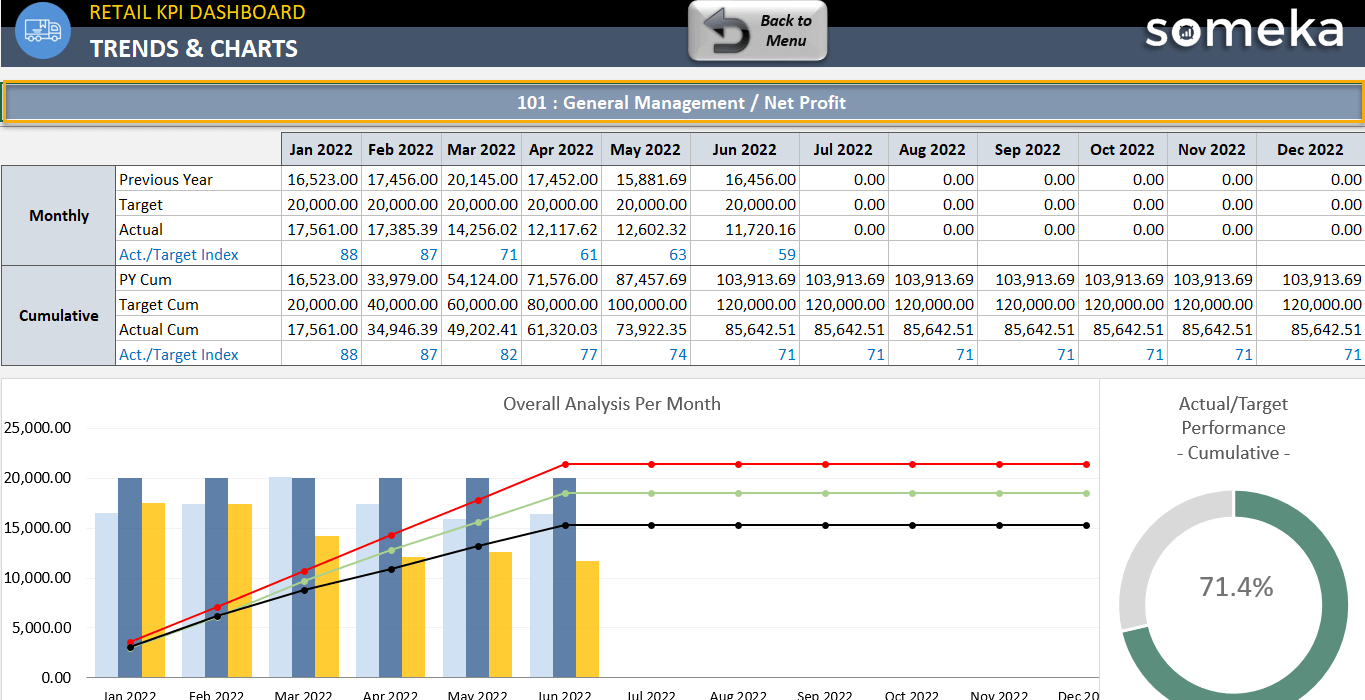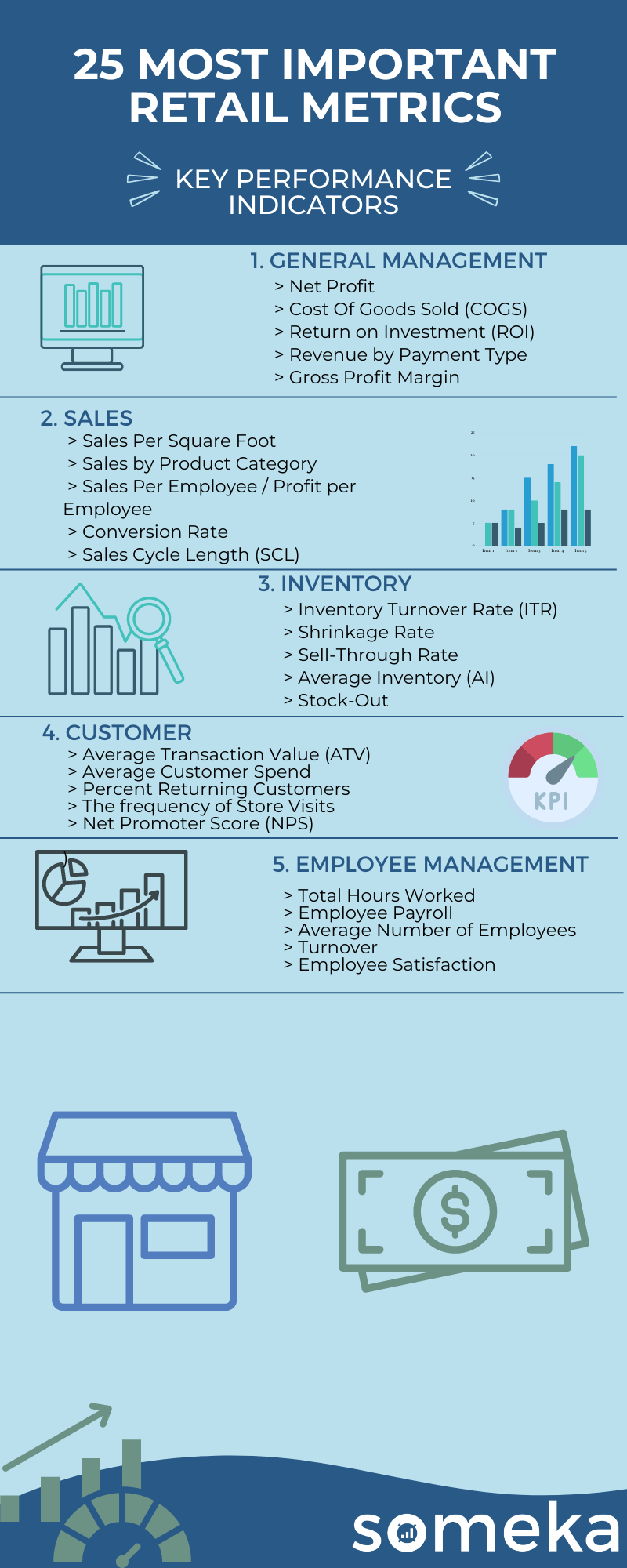
25 Most Important Retail KPIs & Metrics
You are in the retail business and want to analyze your retail processes and track overall performance but don’t know what retail KPIs are and which ones will help your assessments. Here we collected all you need to know about retail metrics and key performance indicators. You can also go and check our Retail Dashboard templates. This dashboard will help you curate all your information in the same place.
What is KPI in retail?
Retail KPIs are key metrics that are used to measure and improve the performance of a retail company or an organization. They are the retail key performance indicators.
Why should you track retail KPIs?
Performance is critical for any retail business’ overall success. So, if you have a retail business or you work for one, tracking the retail KPIs are important to grow your business.
What are the most important KPIs in retail?
There are many KPIs that you can use for your retail business, but you have to apply the right ones to ensure the right results. You can read the 25 most common retail key metrics below.
Retail Metrics

1. Net Profit
Retail Metrics / Revenue / Financial Performance / Profitability
Description:It is the total profit made at the end of the month. It is calculated as total income minus total costs including tax. It shows how profitable is your company month by month. Depend on the size of the company costs will not only grow but they might be quite complex to follow.
Calculation Method / Formula:Revenue – Total Expenses (taxes included)
Should be High or Low?:It may vary depending many factors, like time of the year, new competitors on the market etc. But in case dropping dangerously it may give a strong hint to study the reasons.
2. Cost Of Goods Sold (COGS)
Retail Metrics / Cost / Financial Performance / Profitability / Revenue / Sales
Description:This metrics shows a direct cost of the goods sold per month. Evaluates how efficient a company is in managing their stock supplies and labor.
Calculation Method / Formula:Beginning inventory + cost of Net Purchases – Ending inventory
Should be High or Low?:This is more an informative number to calculate one of the factors for calculating gross profit.
3. Return on Investment (ROI)
Retail Metrics / Revenue / Budget Management / Financial Performance / Investment
Description:The most common profitability metrics used for financial decisions. It helps to analyze how efficient/profitable was your investment. Profit vs Investment
Calculation Method / Formula:Net Profit / Cost of investment
Should be High or Low?:The problem with this metrics is that it doesn’t include time. So, it might be misleading. Depending on your investment you may have results immediately or you need to wait longer time for accurate benefit.
4. Revenue by Payment Type
Retail Metrics / Revenue / Financial Strategies / Market Demand
Description:You can measure which payment method is preferred by your customers. When you have enough information, what are your customer preferences. you can offer some advantages depending on payment method, or you can eliminate some of the unused methods.
Should be High or Low?:This is an information number, growing or going down can suggest popularity of some payment methods over others.
5. Gross Profit Margin
Retail Metrics / Budget Management / Financial Performance / Revenue / Profitability
Description:How much profit you make on each dollar of sales before most of the expenses. The gross profit is calculated by the total revenue reduced by the cost of sale of those goods. Comparing this metrics with Net Profit margin you can also track all the other expenses that are not directly related to COGS.
Calculation Method / Formula:(Sales Revenue-COGS)/Revenue.
Should be High or Low?:If the number is going down, you should consider maybe removing products that doesn’t bring enough income but generates some problems and cost for improvement and customer support. If the gross margin is growing that means the investment in COGS is bringing high income and allows to improve and grow your product and services.
6. Sales Per Square Foot
Retail Metrics / Revenue / Financial Strategies / Sales / Work Effectiveness
Description:It is total sales value per total sale space in your stores (fitting rooms or warehouses are not included as sale space). Depending on the concept of your store you may think about making the space more compact or the opposite. Some of the stores invest is spacious stores when they want to give a customer impression of more luxury place what can give them actually a higher revenue.
Calculation Method / Formula:Net Sales/size of sales space
Should be High or Low?:Informative value
7. Sales by Product Category
Retail Metrics / Revenue / Financial Strategies / Sales / Work Effectiveness
Description:Shows total monetary value of sales by product category. You should categorize your products to measure their sales amount, for that purpose it can be good to split that metrics into each category. That metrics can show you most profitable directions.
Should be High or Low?:Informative value
8. Sales Per Employee / Profit per Employee
Retail Metrics / Revenue / Financial Performance / Profitability / Sales
Description:This metrics can show you how efficient are your employees. You can estimate possible losses or additional income if you think about firing or hiring new employees. This is not one to one implication but can give you a good point of view while seeing changes between that metrics and a number of employees.
Calculation Method / Formula:Total Net sales / FTE
Should be High or Low?:Mainly an informative value but you need to be careful how it changes. Maybe you have hired to many people for current situation or not enough, or maybe you are hiring new people for your new branch. Depend on that this number will be changing.
9. Conversion Rate
Retail Metrics / Sales / Marketing Effectiveness / Digital Marketing / Customer Value / Cost
Description:This metrics shows the percentage out of number of all visitors how many of them actually bought some of your products. The target is to have this number fairly high but even if conversion rate is not very high but the number of visitors is growing your total sales will grow as well.
Calculation Method / Formula:# of successful actions / # of total visits.
Should be High or Low?:You may check how your strategies or product improvement influence on the conversion rate and based on that choose some directions in growing your company.
10. Sales Cycle Length (SCL)
Retail Metrics / Customer Relationship / Sales / Work Effectiveness / Performance
Description:The most used way to monitor sales cycle is to start from the client’s entering till an end when the sale is closed. That metrics depends on your offer and client target. Times will vary depending on number of items your client is going to buy. If you are selling electronic, clients need to get first all technical questions answered, in case of cloths you need to take into account time for try on etc.
Should be High or Low?:If sales cycle length is growing by time, you may think about your sales strategies or try to understand what a cause can be. Maybe if your inventory grew much then your customers also take more time for decision process or maybe there are some problems with your sales manpower.
11. Inventory Turnover Rate (ITR)
Retail Metrics / Revenue / Inventory Management / Budget / Assets / Business Performance
Description:Also known as stock turn and shows how many times (or how big part of) the average inventory is sold per month. It is a bad idea to have higher inventory value than the monthly sales value.
Calculation Method / Formula:Cost of goods used / average warehouse value.
Should be High or Low?:The lower is the ratio the higher are costs of storage/warehouse.
12. Shrinkage Rate
Retail Metrics / Cost / Inventory Management
Description:Shrinkage of your inventory not caused by sales. For the common causes of inventory shrinkage, you can count thefts internal or external, perished goods, defects of the products, lifetime of a product (in case food or cosmetics). It is impossible to eliminate that problem, but you can partially control most of the factors and keep them as low as possible.
Calculation Method / Formula:Ending inventory value – Physically counted inventory value
Should be High or Low?:To try to lower the number you can invest in monitoring of your store, take extra care while getting delivery from producer to check if the products you received have no damages.
13. Sell-Through Rate
Retail Metrics / Work Effectiveness / Market Demand / Revenue / Sales
Description:The percentage of inventory that we sold within some time, in compare to the number goods received in the inventory in the same time.
Calculation Method / Formula: Units sold / (Units sold + On-hand inventory).
Should be High or Low?:With growing number, you may consider increasing value of your inventory orders or their frequency.
14. Average Inventory (AI)
Retail Metrics / Revenue / Inventory Management / Budget / Assets / Business Performance
Description:It is an average of beginning and ending inventory balance. Together with sell-through rate you can measure your warehouse’s effectiveness and take some valuable steps in your inventory maintenance strategies.
Calculation Method / Formula: (Current month inventory + Previous month inventory) /2.
Should be High or Low?:If the number is high together with high sell-through you are on a good direction. But there is no point to keep high inventory if your sell-through goes low.
15. Stock-Out
Retail Metrics / Customer Satisfaction / Cost / Transport / Delivery Management / Inventory Management
Description:A situation in which the required item is not available in the inventory. Stock-out is a bad sign for a customer who will probably start to search for another retailer in the market. If you have a high stock-out level, you should check your other inventory metrics and reorganize it accordingly.
Calculation Method / Formula:Can be measured as a ratio of revenue: Lost sales / (Ravanue + Lost Sales)
or ratio of number of oredered goods: # Out of stok odered goods / (Total number of ordered goods)
Should be High or Low?:The target is to keep the stock-out at minimum but on the other hand you should be careful not to increase your average inventory level high above needs.
16. Average Transaction Value (ATV)
Retail Metrics / Budget Management / Financial Performance / Revenue / Sales /
Description:It counts as an average amount of money spent by your customer. That number depends on the type of your goods.
Calculation Method / Formula:Total sales revenue/Number of transactions (in a period of time)
Should be High or Low?:If the number is changing in a visible way from month to month you should check if there was some specific categories of products that had an impact on the result or maybe some other reason like opening of a new branch etc.
17. ACS / Average Customer Spend
Retail Metrics / Customer Value / Customer Satisfaction / Sales / Revenue
Description:It is almost the same metrics as ATV however here you can take into account a returning client so that number may increase in compare to ATV
Calculation Method / Formula:The total sales revenue/total number of customers (in a period of time)
Should be High or Low?:If the number is changing in a visible way from month to month you should check if there was some specific categories of products that had an impact on the result or maybe some other reason like opening of a new branch etc.
18. Percent Returning Customers
Retail Metrics / Customer Satisfaction / Customer Relationship / Brand Value / Sales
Description:Percent of returning clients is a measure of your brand rate and client satisfaction. Most likely returning customers can also refer your store to others.
Calculation Method / Formula:(The number of returning customers/ the number of total customers) x 100.
Should be High or Low?:Growing number helps build your brand. If the number will start to shrink you should feel alarmed and check your competitors on the market.
19. The frequency of Store Visits
Retail Metrics / Marketing Strategies / Advertising / Marketing Effectiveness / Sales
Description:It is a total number of store visitors per month, also known as foot traffic. You can observe increasing of that number if your store has some special offers or a campaign. But within a time, you should also reach some target value and try to keep or increase by building your label or increasing offer and building a good relationship between you and your customers.
Should be High or Low?:Permanently decreasing number should caught your attention to check the possible reasons.
20. Net Promoter Score (NPS)
Retail Metrics / Customer Satisfaction / Customer Relationship / Brand Value / Sales
Description:That metrics can be used to measure the loyalty or satisfaction of a customer. It shows the quality of relationship between customer and your company. The metrics numbers come from respondents/customers. NPS above zero usually is taken as good result. Respondents who rate your company are usually separated in tree groups: Promoters, Detractors and Passives. On average Promoters buys more, stay loyal customers or even promote your company among other potential customers. The Net Promoter Score is calculated by subtracting the percentage of Detractors from the percentage of Promoters. Number of Passives increase the total number of respondents, and due to that it lowers down the final NPS.
Calculation Method / Formula:% of promoters – % of Detractors
Should be High or Low?:If the number is going down through a period of time, there might be some problem between your company and customers.
21. Total Hours Worked
Retail Metrics / Work Efficiency / Cost / Time Management
Description:The total working hours of employees. Measurement includes total worked time of full-time workers with their average overtime, as well as worked time of part time employees, but you have to exclude the number of hours that comes from vacation, sick leave (on average) and official holidays. This metrics can be useful to calculate efficiency of your workers and to help you to decide if there is a need for increasing a number of your employees.
Should be High or Low?:If your company is growing the number will grow as well.
22. Employee Payroll
Retail Metrics / Employee Satisfaction / Cost / Work Efficiency / Budget Management
Description:The total cost of employee payments. Total cost can grow for example if there is need to hire more people or salaries increases. It also has an influence on your employees work satisfaction rate.
Should be High or Low?:In case of some unpredicted situations or some high number of employee’s turnover rate the number can rise but within the budget you should also calculate how to make your employees satisfied with their job conditions.
23. Average Number of Employees
Retail Metrics / Employee Management / Cost / Work Efficiency / Budget Management / Investment
Description:This number can help you to estimate an optimum number of employees you need in current situation but also it can help you to assume a number of new employees in case of opening new branch.
Calculation Method / Formula: (The numbers of active employees at the beginning + The numbers of active employees at the end)/2
Should be High or Low?:This is an informative number that can help you understand your capacity as an employer.
24. Turnover
Retail Metrics / Employee Satisfaction / Cost / Work Efficiency / Budget Management
Description:This is a percentage of workers who leave and are replaced by new employees within some period of time.
Calculation Method / Formula:#of Employees separated / Average #of employees
Should be High or Low?:High number may lower the qualifications or increase the defect ratio due to less experience. Also, it increases a cost of the labor due to much lower productivity of the new employees. You should reconsider your employment strategy.
25. Employee Satisfaction
Retail Metrics / Employee Satisfaction / Employee Management / Budget Management
Description:To decrease your turnover rate, you should measure the employees’ work satisfaction. Check on their needs, complaints and engagement at work. You may create and follow a survey among them to understand the level of their happiness and satisfaction.
Should be High or Low?:It is important to keep the rate high, because that usually means better work results, less mistakes, better work atmosphere etc.
Below is the summary of Retail KPI metrics:
Most Important KPIs for Different Industries
Retail KPIs are specific for retail businesses and if you work in a different industry, they might not be the right one for you. Learn more about the other industries with our KPI blog posts for every industry.



